belt FORD BRONCO 2021 Warranty Guide
[x] Cancel search | Manufacturer: FORD, Model Year: 2021, Model line: BRONCO, Model: FORD BRONCO 2021Pages: 106, PDF Size: 2.6 MB
Page 4 of 106

Introduction
About This Publication
..................................5
Data Privacy
Event Data ..........................................................
7
Child Safety
Child Safety Precautions ..............................
8
Child Restraint Anchor Points .....................
9
Child Restraints ..............................................
10
Installing Child Restraints ...........................
12
Booster Seats ..................................................
16
Seatbelts
Seatbelt Precautions ....................................
19
Fastening and Unfastening the Seatbelts ........................................................................\
..
20
Sensitive Locking Mode ..............................
20
Automatic Locking Mode ............................
21
Adjusting the Seatbelts During Pregnancy .....................................................
21
Seatbelt Reminder .........................................
21
Seatbelt Extensions .....................................
24
Personal Safety System ™
What Is the Personal Safety System ........................................................................\
...
25
How Does the Personal Safety System Work ...............................................................
25
Personal Safety System Components ........................................................................\
...
25
Airbags
How Do the Front Airbags Work ..............
26
How Do the Side Airbags Work ................
26
How Does the Safety Canopy ™ Work
........................................................................\
...
27
Airbag Precautions .......................................
28
Properly Adjusting the Driver and Front Passenger Seats ........................................
29
Children and Airbags ...................................
29Front Passenger Sensing System
...........
30
Crash Sensors and Airbag Indicator .......
32
Disposing of Airbags ....................................
33
Keys and Remote Controls
Removing the Key Blade ............................
34
Replacing a Lost Key or Remote Control ........................................................................\
..
34
Security
Passive Anti-Theft System ........................
35
Wipers and Washers
Wipers ...............................................................
36
Checking the Wiper Blades .......................
36
Replacing the Front Wiper Blades ..........
36
Washers .............................................................
37
Wipers and Washers – Troubleshooting ........................................................................\
..
38
Instrument Cluster
Instrument Cluster Warning Lamps ......
39
Instrument Cluster Indicators ..................
40
Climate Control - Vehicles With: Automatic
Temperature Control
Identifying the Climate Control Unit ......
43
Switching Climate Control On and Off ........................................................................\
..
43
Switching Maximum Defrost On and Off ........................................................................\
..
43
Switching the Heated Rear Window On and Off ..........................................................
43
Setting the Blower Motor Speed .............
43
Setting the Temperature ............................
44
Directing the Flow of Air .............................
44
Climate Control Hints ..................................
44
1
2021 Bronco (TG1) Canada/United States of America, enUSA, Edition date: 202101, First-Printing Table of Contents
Page 10 of 106
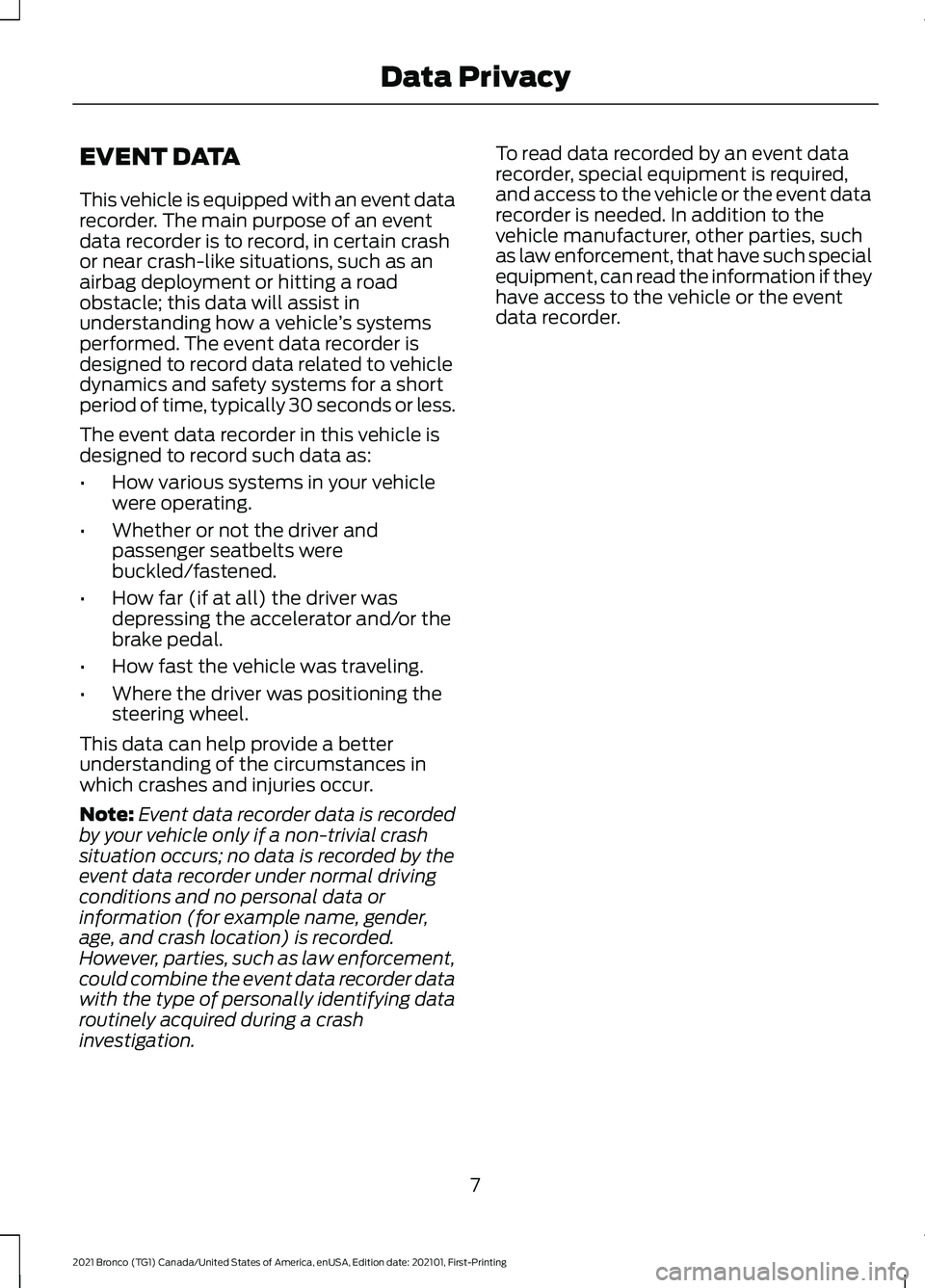
EVENT DATA
This vehicle is equipped with an event data
recorder. The main purpose of an event
data recorder is to record, in certain crash
or near crash-like situations, such as an
airbag deployment or hitting a road
obstacle; this data will assist in
understanding how a vehicle
’s systems
performed. The event data recorder is
designed to record data related to vehicle
dynamics and safety systems for a short
period of time, typically 30 seconds or less.
The event data recorder in this vehicle is
designed to record such data as:
• How various systems in your vehicle
were operating.
• Whether or not the driver and
passenger seatbelts were
buckled/fastened.
• How far (if at all) the driver was
depressing the accelerator and/or the
brake pedal.
• How fast the vehicle was traveling.
• Where the driver was positioning the
steering wheel.
This data can help provide a better
understanding of the circumstances in
which crashes and injuries occur.
Note: Event data recorder data is recorded
by your vehicle only if a non-trivial crash
situation occurs; no data is recorded by the
event data recorder under normal driving
conditions and no personal data or
information (for example name, gender,
age, and crash location) is recorded.
However, parties, such as law enforcement,
could combine the event data recorder data
with the type of personally identifying data
routinely acquired during a crash
investigation. To read data recorded by an event data
recorder, special equipment is required,
and access to the vehicle or the event data
recorder is needed. In addition to the
vehicle manufacturer, other parties, such
as law enforcement, that have such special
equipment, can read the information if they
have access to the vehicle or the event
data recorder.
7
2021 Bronco (TG1) Canada/United States of America, enUSA, Edition date: 202101, First-Printing Data Privacy
Page 12 of 106
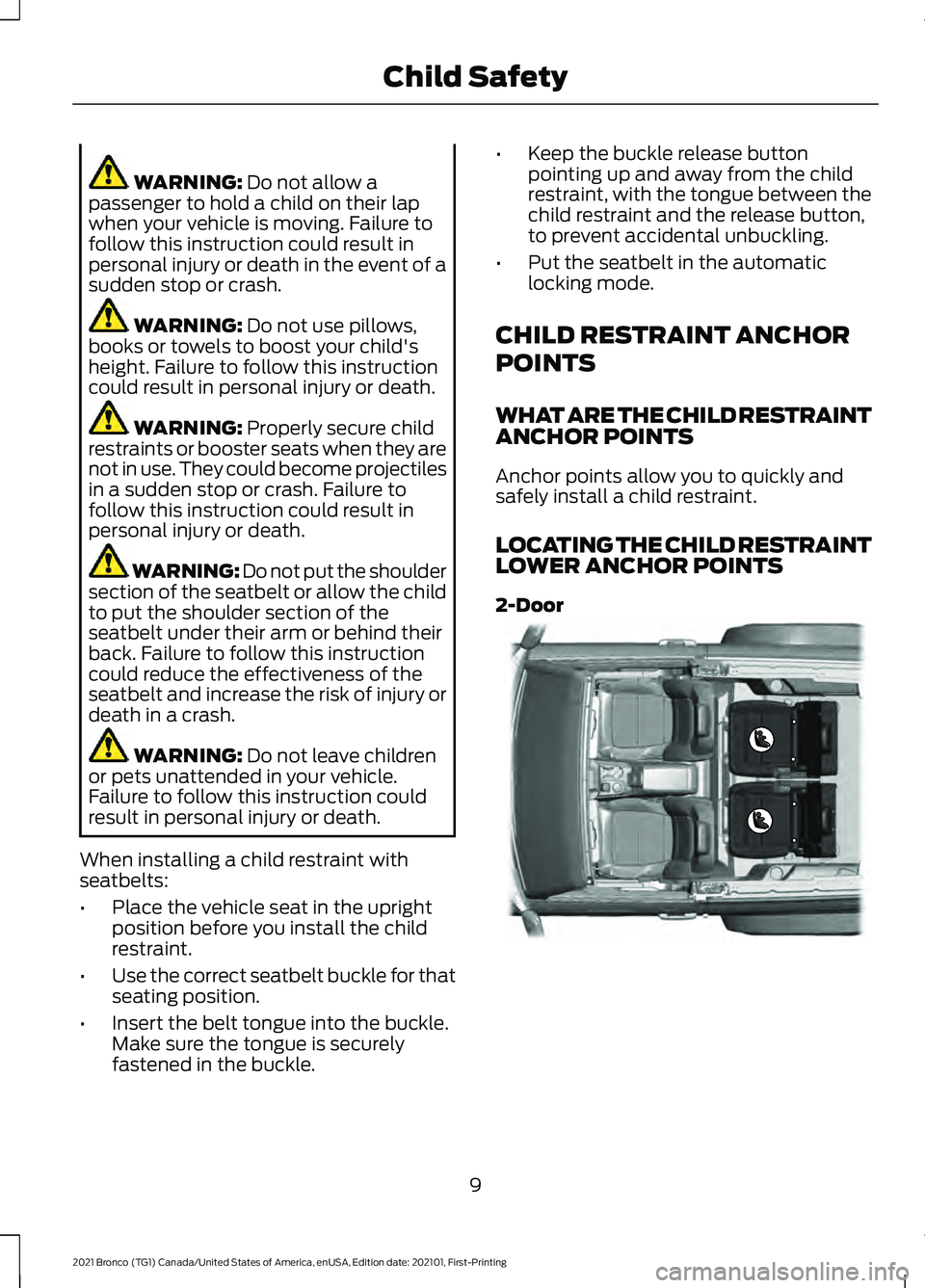
WARNING: Do not allow a
passenger to hold a child on their lap
when your vehicle is moving. Failure to
follow this instruction could result in
personal injury or death in the event of a
sudden stop or crash. WARNING:
Do not use pillows,
books or towels to boost your child's
height. Failure to follow this instruction
could result in personal injury or death. WARNING:
Properly secure child
restraints or booster seats when they are
not in use. They could become projectiles
in a sudden stop or crash. Failure to
follow this instruction could result in
personal injury or death. WARNING: Do not put the shoulder
section of the seatbelt or allow the child
to put the shoulder section of the
seatbelt under their arm or behind their
back. Failure to follow this instruction
could reduce the effectiveness of the
seatbelt and increase the risk of injury or
death in a crash. WARNING:
Do not leave children
or pets unattended in your vehicle.
Failure to follow this instruction could
result in personal injury or death.
When installing a child restraint with
seatbelts:
• Place the vehicle seat in the upright
position before you install the child
restraint.
• Use the correct seatbelt buckle for that
seating position.
• Insert the belt tongue into the buckle.
Make sure the tongue is securely
fastened in the buckle. •
Keep the buckle release button
pointing up and away from the child
restraint, with the tongue between the
child restraint and the release button,
to prevent accidental unbuckling.
• Put the seatbelt in the automatic
locking mode.
CHILD RESTRAINT ANCHOR
POINTS
WHAT ARE THE CHILD RESTRAINT
ANCHOR POINTS
Anchor points allow you to quickly and
safely install a child restraint.
LOCATING THE CHILD RESTRAINT
LOWER ANCHOR POINTS
2-Door 9
2021 Bronco (TG1) Canada/United States of America, enUSA, Edition date: 202101, First-Printing Child SafetyE328020
Page 13 of 106
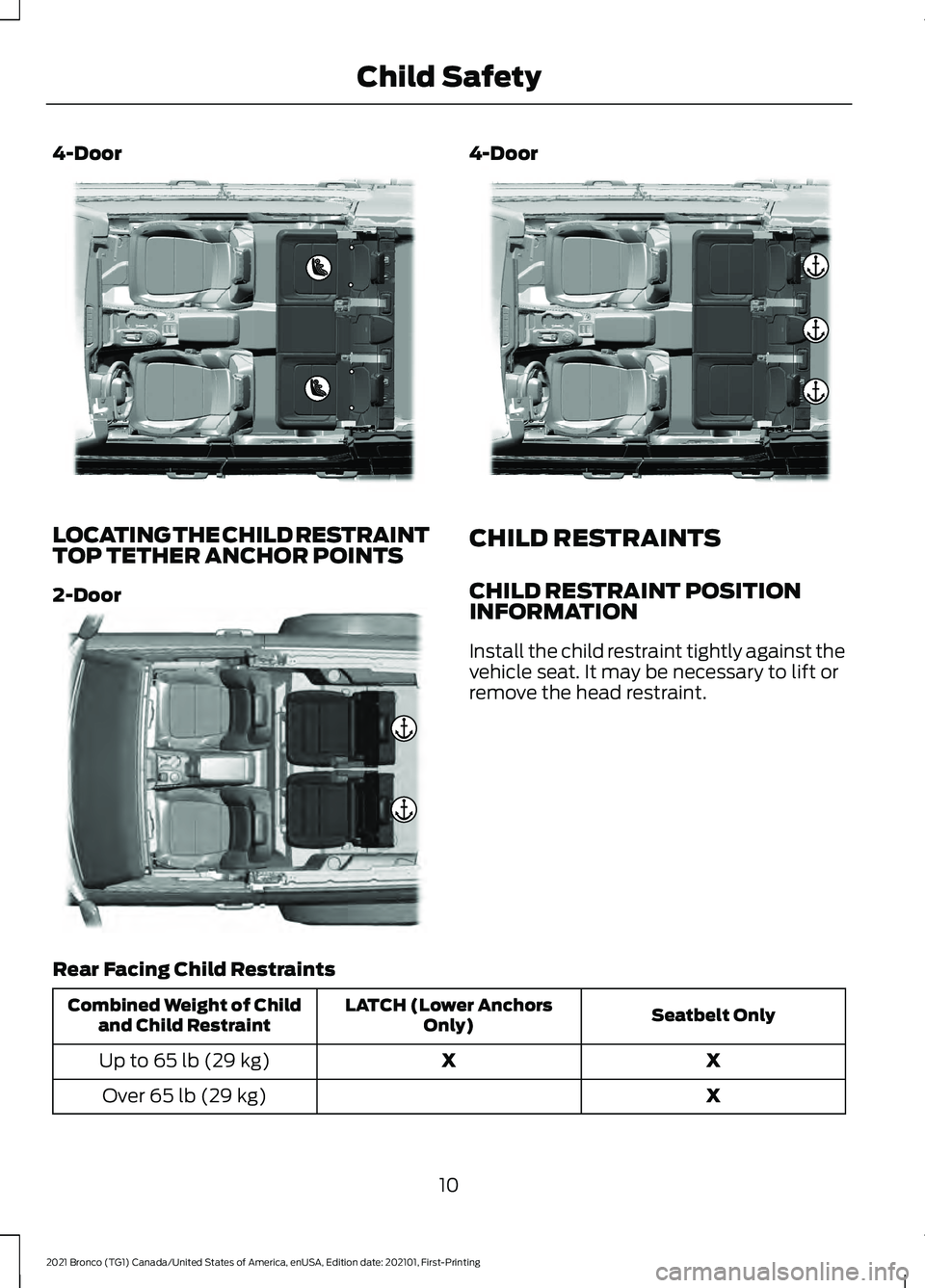
4-Door
LOCATING THE CHILD RESTRAINT
TOP TETHER ANCHOR POINTS
2-Door 4-Door
CHILD RESTRAINTS
CHILD RESTRAINT POSITION
INFORMATION
Install the child restraint tightly against the
vehicle seat. It may be necessary to lift or
remove the head restraint.
Rear Facing Child Restraints Seatbelt Only
LATCH (Lower Anchors
Only)
Combined Weight of Child
and Child Restraint
X
X
Up to 65 lb (29 kg)
X
Over
65 lb (29 kg)
10
2021 Bronco (TG1) Canada/United States of America, enUSA, Edition date: 202101, First-Printing Child SafetyE323300 E328021 E323301
Page 14 of 106
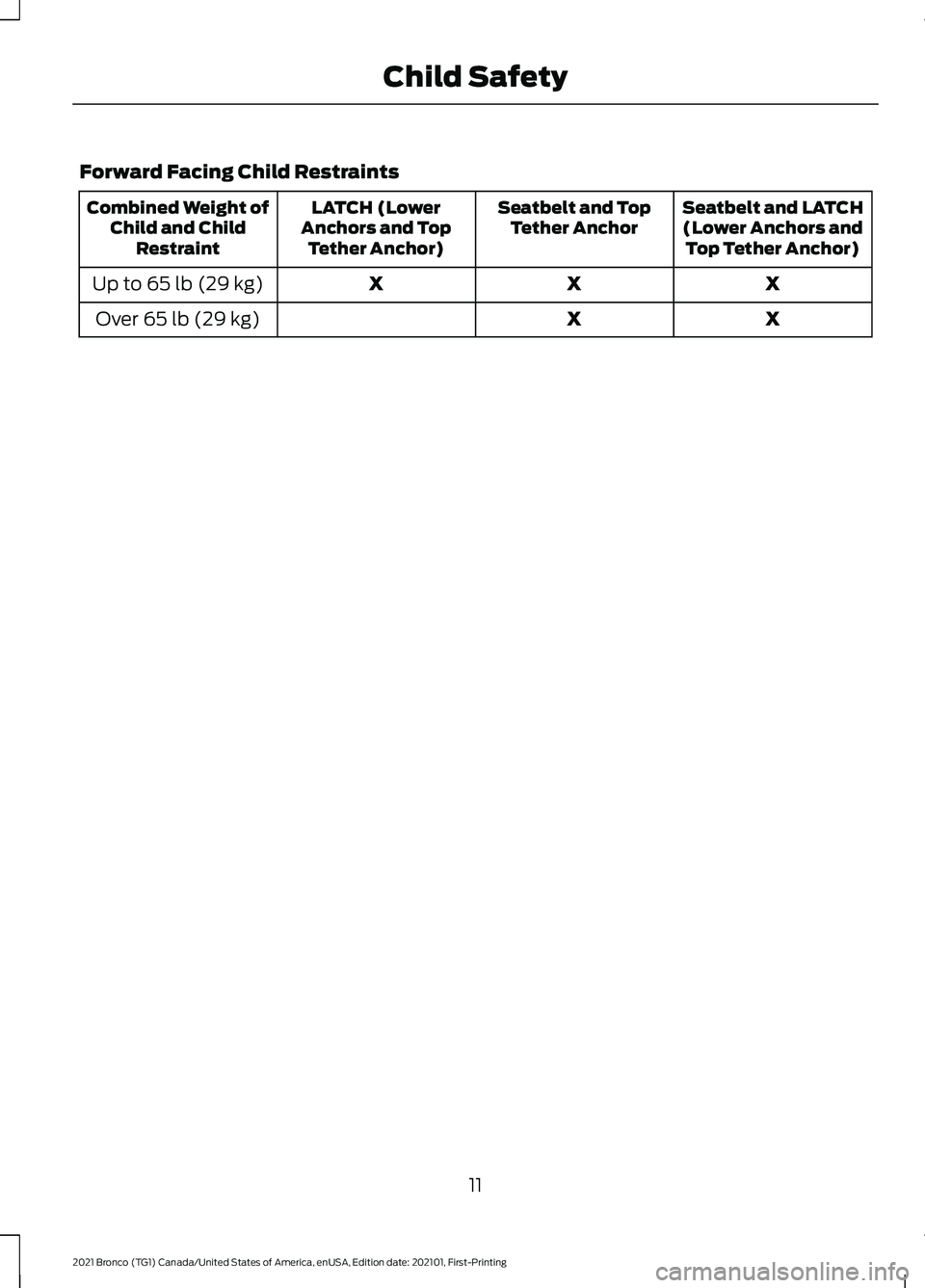
Forward Facing Child Restraints
Seatbelt and LATCH
(Lower Anchors and Top Tether Anchor)
Seatbelt and Top
Tether Anchor
LATCH (Lower
Anchors and Top Tether Anchor)
Combined Weight of
Child and Child Restraint
X
X
X
Up to 65 lb (29 kg)
X
X
Over
65 lb (29 kg)
11
2021 Bronco (TG1) Canada/United States of America, enUSA, Edition date: 202101, First-Printing Child Safety
Page 15 of 106
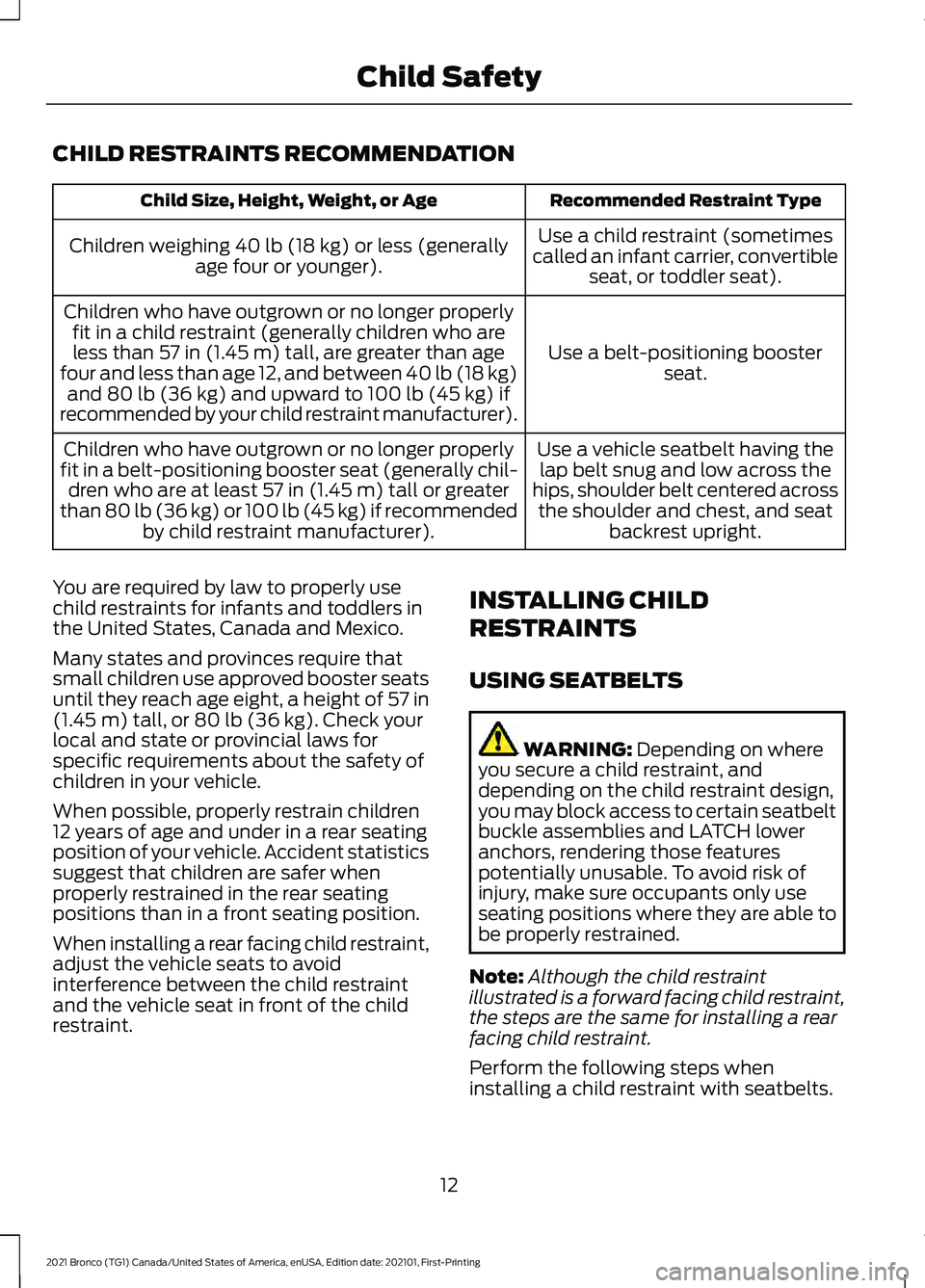
CHILD RESTRAINTS RECOMMENDATION
Recommended Restraint Type
Child Size, Height, Weight, or Age
Use a child restraint (sometimes
called an infant carrier, convertible seat, or toddler seat).
Children weighing 40 lb (18 kg) or less (generally
age four or younger).
Use a belt-positioning boosterseat.
Children who have outgrown or no longer properly
fit in a child restraint (generally children who areless than
57 in (1.45 m) tall, are greater than age
four and less than age 12, and between 40 lb (18 kg) and
80 lb (36 kg) and upward to 100 lb (45 kg) if
recommended by your child restraint manufacturer).
Use a vehicle seatbelt having thelap belt snug and low across the
hips, shoulder belt centered across the shoulder and chest, and seat backrest upright.
Children who have outgrown or no longer properly
fit in a belt-positioning booster seat (generally chil- dren who are at least
57 in (1.45 m) tall or greater
than 80 lb (36 kg) or 100 lb (45 kg) if recommended by child restraint manufacturer).
You are required by law to properly use
child restraints for infants and toddlers in
the United States, Canada and Mexico.
Many states and provinces require that
small children use approved booster seats
until they reach age eight, a height of 57 in
(1.45 m)
tall, or 80 lb (36 kg). Check your
local and state or provincial laws for
specific requirements about the safety of
children in your vehicle.
When possible, properly restrain children
12 years of age and under in a rear seating
position of your vehicle. Accident statistics
suggest that children are safer when
properly restrained in the rear seating
positions than in a front seating position.
When installing a rear facing child restraint,
adjust the vehicle seats to avoid
interference between the child restraint
and the vehicle seat in front of the child
restraint. INSTALLING CHILD
RESTRAINTS
USING SEATBELTS WARNING:
Depending on where
you secure a child restraint, and
depending on the child restraint design,
you may block access to certain seatbelt
buckle assemblies and LATCH lower
anchors, rendering those features
potentially unusable. To avoid risk of
injury, make sure occupants only use
seating positions where they are able to
be properly restrained.
Note: Although the child restraint
illustrated is a forward facing child restraint,
the steps are the same for installing a rear
facing child restraint.
Perform the following steps when
installing a child restraint with seatbelts.
12
2021 Bronco (TG1) Canada/United States of America, enUSA, Edition date: 202101, First-Printing Child Safety
Page 16 of 106
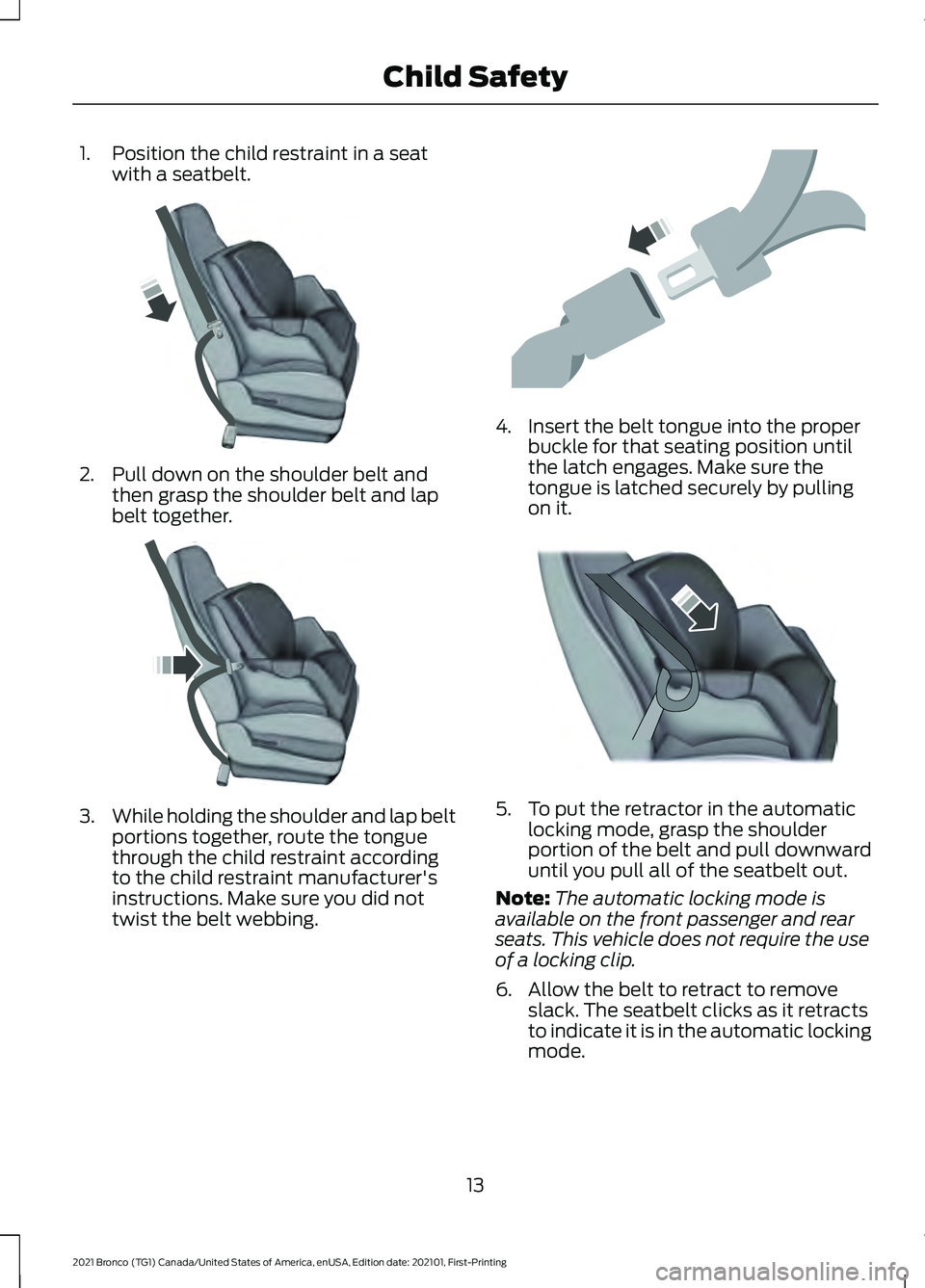
1. Position the child restraint in a seat
with a seatbelt. 2. Pull down on the shoulder belt and
then grasp the shoulder belt and lap
belt together. 3.
While holding the shoulder and lap belt
portions together, route the tongue
through the child restraint according
to the child restraint manufacturer's
instructions. Make sure you did not
twist the belt webbing. 4. Insert the belt tongue into the proper
buckle for that seating position until
the latch engages. Make sure the
tongue is latched securely by pulling
on it. 5. To put the retractor in the automatic
locking mode, grasp the shoulder
portion of the belt and pull downward
until you pull all of the seatbelt out.
Note: The automatic locking mode is
available on the front passenger and rear
seats. This vehicle does not require the use
of a locking clip.
6. Allow the belt to retract to remove slack. The seatbelt clicks as it retracts
to indicate it is in the automatic locking
mode.
13
2021 Bronco (TG1) Canada/United States of America, enUSA, Edition date: 202101, First-Printing Child SafetyE142529 E142530 E142531 E142875
Page 17 of 106
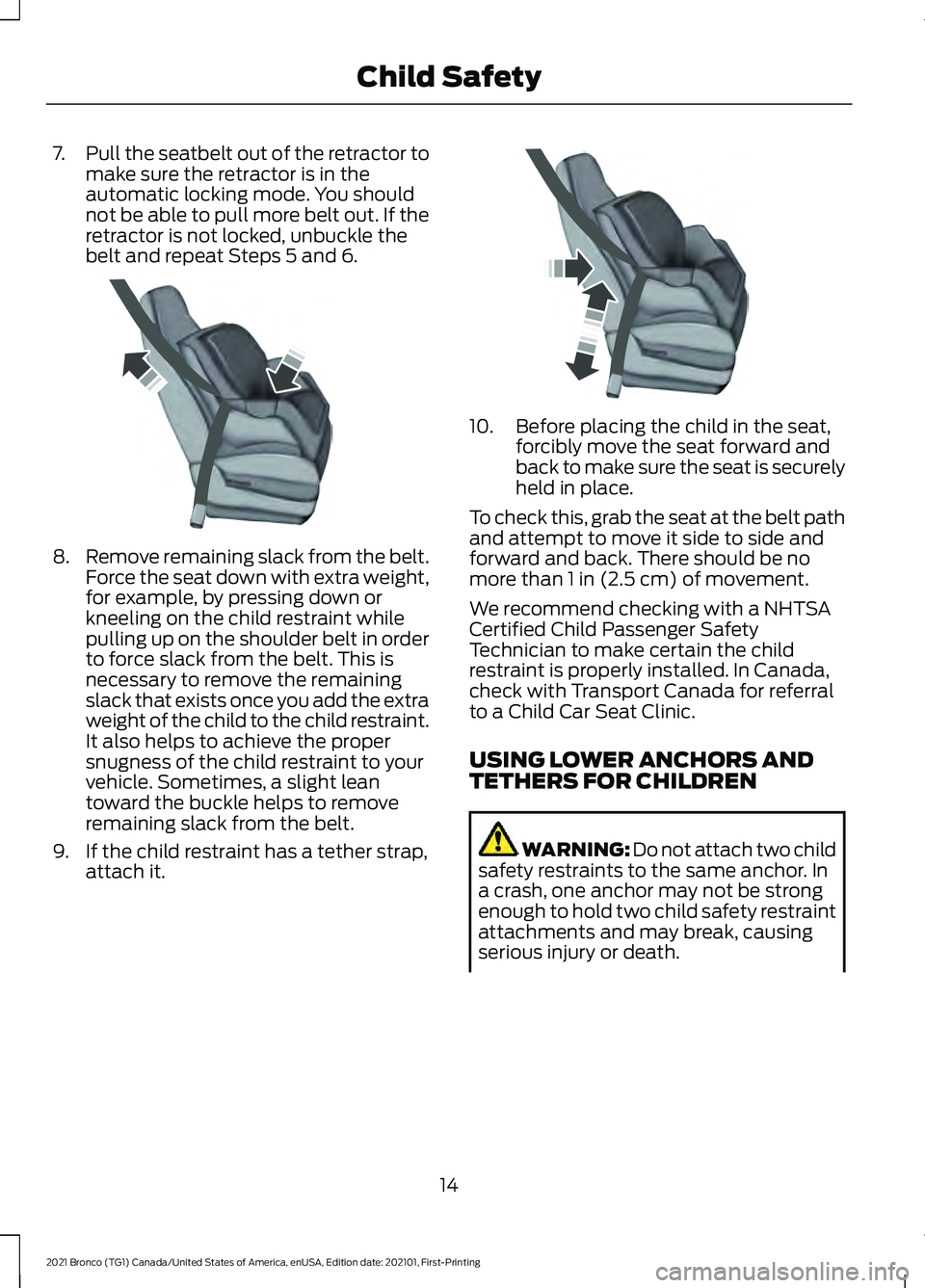
7.
Pull the seatbelt out of the retractor to
make sure the retractor is in the
automatic locking mode. You should
not be able to pull more belt out. If the
retractor is not locked, unbuckle the
belt and repeat Steps 5 and 6. 8.
Remove remaining slack from the belt.
Force the seat down with extra weight,
for example, by pressing down or
kneeling on the child restraint while
pulling up on the shoulder belt in order
to force slack from the belt. This is
necessary to remove the remaining
slack that exists once you add the extra
weight of the child to the child restraint.
It also helps to achieve the proper
snugness of the child restraint to your
vehicle. Sometimes, a slight lean
toward the buckle helps to remove
remaining slack from the belt.
9. If the child restraint has a tether strap, attach it. 10. Before placing the child in the seat,
forcibly move the seat forward and
back to make sure the seat is securely
held in place.
To check this, grab the seat at the belt path
and attempt to move it side to side and
forward and back. There should be no
more than 1 in (2.5 cm) of movement.
We recommend checking with a NHTSA
Certified Child Passenger Safety
Technician to make certain the child
restraint is properly installed. In Canada,
check with Transport Canada for referral
to a Child Car Seat Clinic.
USING LOWER ANCHORS AND
TETHERS FOR CHILDREN WARNING: Do not attach two child
safety restraints to the same anchor. In
a crash, one anchor may not be strong
enough to hold two child safety restraint
attachments and may break, causing
serious injury or death.
14
2021 Bronco (TG1) Canada/United States of America, enUSA, Edition date: 202101, First-Printing Child SafetyE142533 E142534
Page 18 of 106
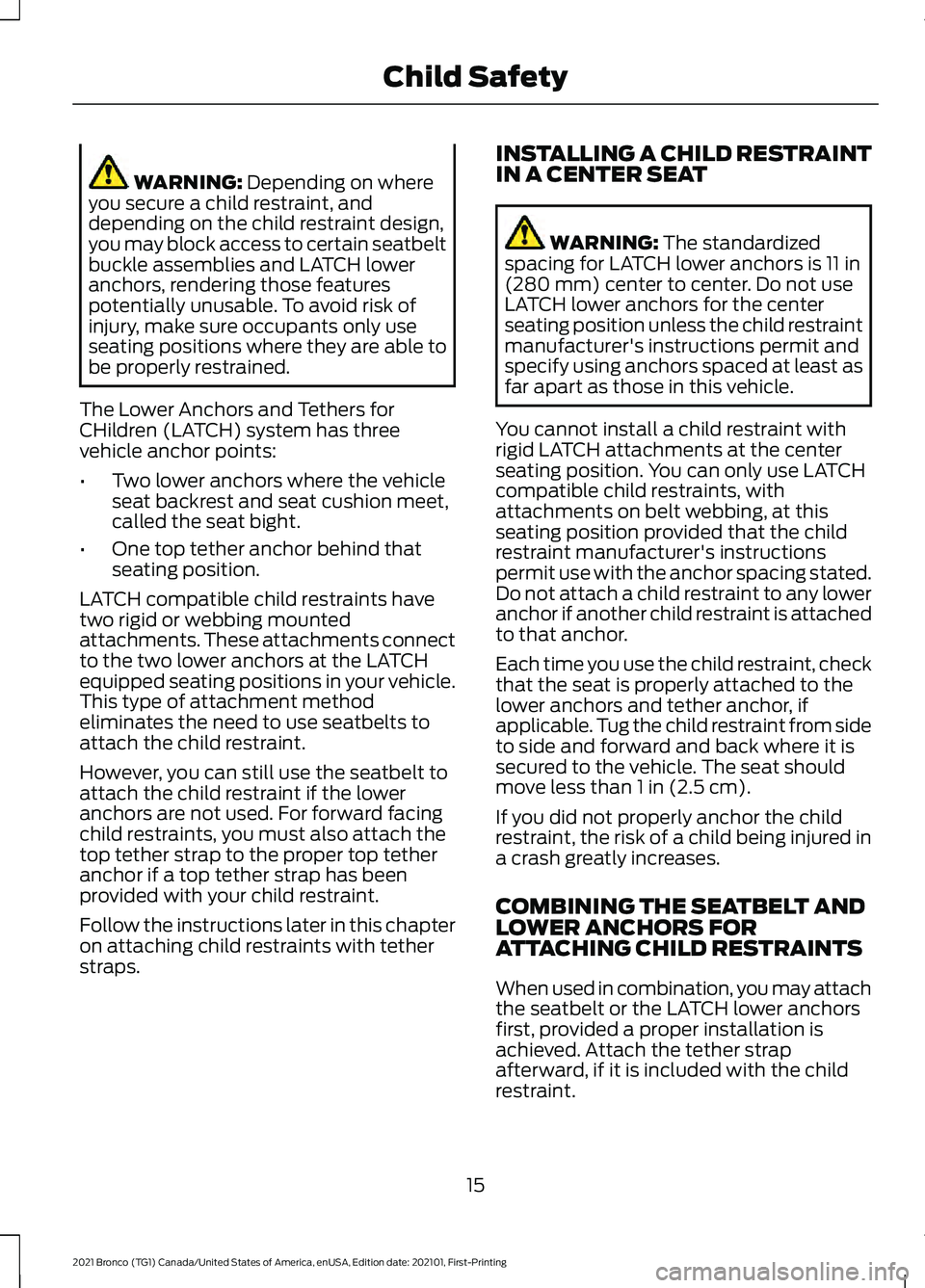
WARNING: Depending on where
you secure a child restraint, and
depending on the child restraint design,
you may block access to certain seatbelt
buckle assemblies and LATCH lower
anchors, rendering those features
potentially unusable. To avoid risk of
injury, make sure occupants only use
seating positions where they are able to
be properly restrained.
The Lower Anchors and Tethers for
CHildren (LATCH) system has three
vehicle anchor points:
• Two lower anchors where the vehicle
seat backrest and seat cushion meet,
called the seat bight.
• One top tether anchor behind that
seating position.
LATCH compatible child restraints have
two rigid or webbing mounted
attachments. These attachments connect
to the two lower anchors at the LATCH
equipped seating positions in your vehicle.
This type of attachment method
eliminates the need to use seatbelts to
attach the child restraint.
However, you can still use the seatbelt to
attach the child restraint if the lower
anchors are not used. For forward facing
child restraints, you must also attach the
top tether strap to the proper top tether
anchor if a top tether strap has been
provided with your child restraint.
Follow the instructions later in this chapter
on attaching child restraints with tether
straps. INSTALLING A CHILD RESTRAINT
IN A CENTER SEAT WARNING:
The standardized
spacing for LATCH lower anchors is 11 in
(280 mm) center to center. Do not use
LATCH lower anchors for the center
seating position unless the child restraint
manufacturer's instructions permit and
specify using anchors spaced at least as
far apart as those in this vehicle.
You cannot install a child restraint with
rigid LATCH attachments at the center
seating position. You can only use LATCH
compatible child restraints, with
attachments on belt webbing, at this
seating position provided that the child
restraint manufacturer's instructions
permit use with the anchor spacing stated.
Do not attach a child restraint to any lower
anchor if another child restraint is attached
to that anchor.
Each time you use the child restraint, check
that the seat is properly attached to the
lower anchors and tether anchor, if
applicable. Tug the child restraint from side
to side and forward and back where it is
secured to the vehicle. The seat should
move less than
1 in (2.5 cm).
If you did not properly anchor the child
restraint, the risk of a child being injured in
a crash greatly increases.
COMBINING THE SEATBELT AND
LOWER ANCHORS FOR
ATTACHING CHILD RESTRAINTS
When used in combination, you may attach
the seatbelt or the LATCH lower anchors
first, provided a proper installation is
achieved. Attach the tether strap
afterward, if it is included with the child
restraint.
15
2021 Bronco (TG1) Canada/United States of America, enUSA, Edition date: 202101, First-Printing Child Safety
Page 19 of 106
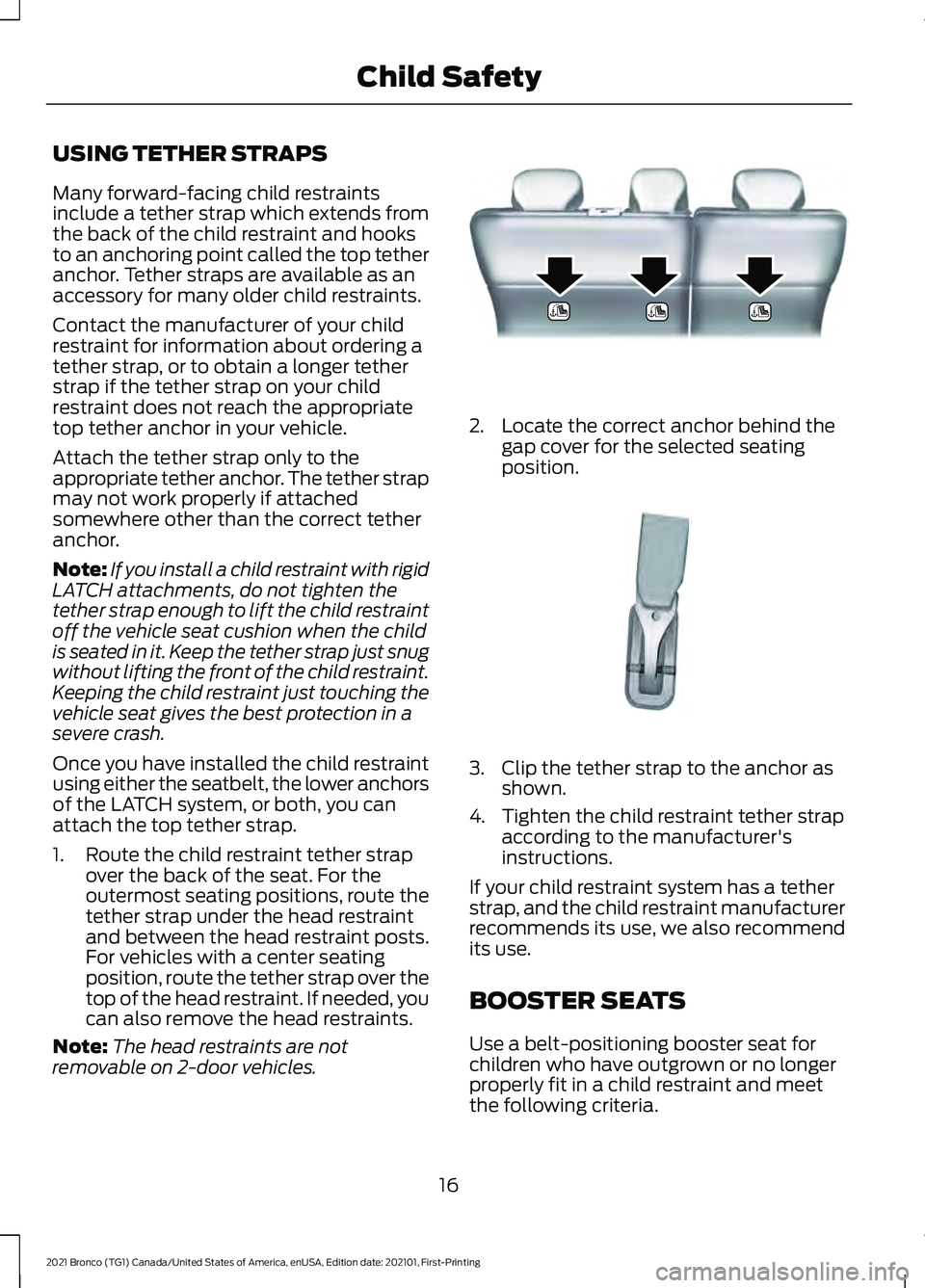
USING TETHER STRAPS
Many forward-facing child restraints
include a tether strap which extends from
the back of the child restraint and hooks
to an anchoring point called the top tether
anchor. Tether straps are available as an
accessory for many older child restraints.
Contact the manufacturer of your child
restraint for information about ordering a
tether strap, or to obtain a longer tether
strap if the tether strap on your child
restraint does not reach the appropriate
top tether anchor in your vehicle.
Attach the tether strap only to the
appropriate tether anchor. The tether strap
may not work properly if attached
somewhere other than the correct tether
anchor.
Note:
If you install a child restraint with rigid
LATCH attachments, do not tighten the
tether strap enough to lift the child restraint
off the vehicle seat cushion when the child
is seated in it. Keep the tether strap just snug
without lifting the front of the child restraint.
Keeping the child restraint just touching the
vehicle seat gives the best protection in a
severe crash.
Once you have installed the child restraint
using either the seatbelt, the lower anchors
of the LATCH system, or both, you can
attach the top tether strap.
1. Route the child restraint tether strap over the back of the seat. For the
outermost seating positions, route the
tether strap under the head restraint
and between the head restraint posts.
For vehicles with a center seating
position, route the tether strap over the
top of the head restraint. If needed, you
can also remove the head restraints.
Note: The head restraints are not
removable on 2-door vehicles. 2. Locate the correct anchor behind the
gap cover for the selected seating
position. 3. Clip the tether strap to the anchor as
shown.
4. Tighten the child restraint tether strap according to the manufacturer's
instructions.
If your child restraint system has a tether
strap, and the child restraint manufacturer
recommends its use, we also recommend
its use.
BOOSTER SEATS
Use a belt-positioning booster seat for
children who have outgrown or no longer
properly fit in a child restraint and meet
the following criteria.
16
2021 Bronco (TG1) Canada/United States of America, enUSA, Edition date: 202101, First-Printing Child SafetyE193589 E142539